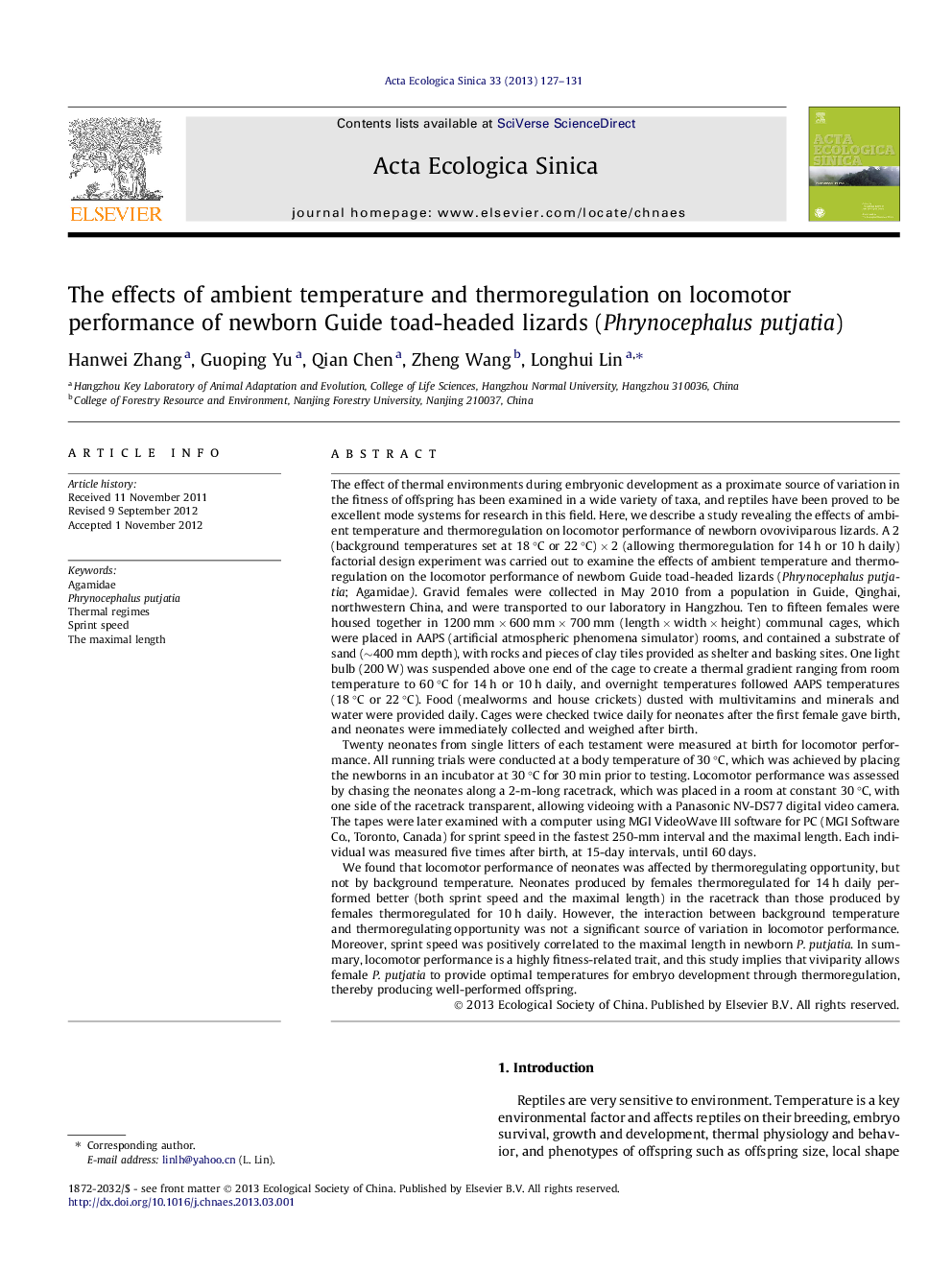| کد مقاله | کد نشریه | سال انتشار | مقاله انگلیسی | نسخه تمام متن |
|---|---|---|---|---|
| 4379848 | 1303944 | 2013 | 5 صفحه PDF | دانلود رایگان |

The effect of thermal environments during embryonic development as a proximate source of variation in the fitness of offspring has been examined in a wide variety of taxa, and reptiles have been proved to be excellent mode systems for research in this field. Here, we describe a study revealing the effects of ambient temperature and thermoregulation on locomotor performance of newborn ovoviviparous lizards. A 2 (background temperatures set at 18 °C or 22 °C) × 2 (allowing thermoregulation for 14 h or 10 h daily) factorial design experiment was carried out to examine the effects of ambient temperature and thermoregulation on the locomotor performance of newborn Guide toad-headed lizards (Phrynocephalus putjatia; Agamidae). Gravid females were collected in May 2010 from a population in Guide, Qinghai, northwestern China, and were transported to our laboratory in Hangzhou. Ten to fifteen females were housed together in 1200 mm × 600 mm × 700 mm (length × width × height) communal cages, which were placed in AAPS (artificial atmospheric phenomena simulator) rooms, and contained a substrate of sand (∼400 mm depth), with rocks and pieces of clay tiles provided as shelter and basking sites. One light bulb (200 W) was suspended above one end of the cage to create a thermal gradient ranging from room temperature to 60 °C for 14 h or 10 h daily, and overnight temperatures followed AAPS temperatures (18 °C or 22 °C). Food (mealworms and house crickets) dusted with multivitamins and minerals and water were provided daily. Cages were checked twice daily for neonates after the first female gave birth, and neonates were immediately collected and weighed after birth.Twenty neonates from single litters of each testament were measured at birth for locomotor performance. All running trials were conducted at a body temperature of 30 °C, which was achieved by placing the newborns in an incubator at 30 °C for 30 min prior to testing. Locomotor performance was assessed by chasing the neonates along a 2-m-long racetrack, which was placed in a room at constant 30 °C, with one side of the racetrack transparent, allowing videoing with a Panasonic NV-DS77 digital video camera. The tapes were later examined with a computer using MGI VideoWave III software for PC (MGI Software Co., Toronto, Canada) for sprint speed in the fastest 250-mm interval and the maximal length. Each individual was measured five times after birth, at 15-day intervals, until 60 days.We found that locomotor performance of neonates was affected by thermoregulating opportunity, but not by background temperature. Neonates produced by females thermoregulated for 14 h daily performed better (both sprint speed and the maximal length) in the racetrack than those produced by females thermoregulated for 10 h daily. However, the interaction between background temperature and thermoregulating opportunity was not a significant source of variation in locomotor performance. Moreover, sprint speed was positively correlated to the maximal length in newborn P. putjatia. In summary, locomotor performance is a highly fitness-related trait, and this study implies that viviparity allows female P. putjatia to provide optimal temperatures for embryo development through thermoregulation, thereby producing well-performed offspring.
Journal: Acta Ecologica Sinica - Volume 33, Issue 3, June 2013, Pages 127–131